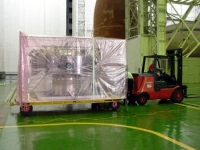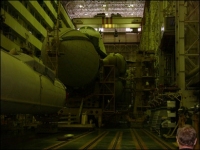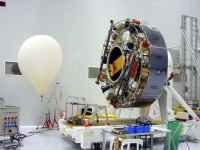10 - 20 May 2000
21 May 2000
All four spacecraft are being prepared in parallel in the 3 brand new clean rooms, built by Starsem a few months ago. The reporting period saw the completion of electrical tests for FM 7 and FM 8. FM 6 completed its Reaction Control System (RCS) verification in the HPF area. In the UCIF thruster installation was completed successfully for FM 5. The end-to-end test of 3 spacecraft (SVT tests) were completed for FM 6, 7 and 8. The SVT test for FM 5 will follow later.May 20 (evening)
To relax a bit from a long week, we had a small barbecue party at the Sputnik hotel with people from industry and Starsem, organised jointly by the hotel and ESA.
May 20
Several boom deployments have been performed on the FM 7 spacecraft. There are 2 types of booms, which will be deployed once the satellite is in orbit. They include two single-hinged communication antennae, which extend parallel to the spacecraft's spinning axis, and two double-hinged booms on the satellite's upper platform, which deploy radially and carry several experiments.
During the on-ground test deployment, balloons filled with helium are attached to the boom to compensate for the pull of gravity on the boom. No radial or vertical force must be applied on the boom during the deployment.
 |
 |
|
These pictures show the deployment of the experiment boom. The operation is led by Ivady Andras, Abt Georg and Beckert Wolfram from DSS. | |
In orbit, the deployment is triggered by a spring-loaded system, assisted by the centrifugal force of the spinning spacecraft. On the ground, to simulate this centrifugal force, a little fan is also mounted on the boom. This delicate operation takes about ½ day per boom.
In parallel, activities are starting to set up the equipment for the battery conditioning.
May 19
 |
|
The transfer of FM 6 with a specially developed transport carrier |
The spacecraft ballet between the various clean rooms is continuing, with a lot of activities. At one moment, yesterday, there were 3 spacecraft in the Payload Processing Facility (PPF) clean room!
After completion of the RCS tests, FM 6 was transferred from the Hazardous Processing Facility (HPF) room to the PPF room for the Spacecraft Verification (SVT) test on a special trolley developed for that purpose. The SVT test took place successfully the same day.
In parallel, thrusters are being remounted on the FM 8 spacecraft, which was also moved from the PPF to the Upper Composite Integration Facility (UCIF), after successful completion of the SVT the day before.
In the meantime, the FM 5 spacecraft is in the (HPF) for a Reaction Control System (RCS) functional and leak test.
18 May
- After completion of the RCS tests, FM 6 has been transferred from the HPF room to the PPF room for the SVT tests on a special trolley developed for that purpose.
-
An important task, nearing completion, is the final manufacturing of the last batch of the thermal blankets and their verification (conductivity) before mounting on the spacecraft. This long and arduous work (sewing skills required!) is very important for the good operation of the satellites. Despite their known function of providing a good thermal environment to the satellite, the blankets must be electrically conductive to avoid building of electrical charges on the spacecraft, which can be dangerous to the operation of some sub-systems and some experiments. Therefore, the upper layer of the thermal blanket (facing space) is covered with a thin ITO conductive layer, which needs to be accurately verified. Then, once integrated on the spacecraft in June, all the thermal blankets will be grounded to a common point.
Thermal blanket preparation and verification with the Dornier thermal team at work. From left to right: Peter Blaser, Peter Groessner, and Thomas Schmidt.
17 May
 |
 |
- Since yesterday, the winds and the clouds have almost disappeared indicating that the warm season is coming very soon. For the time being, we still enjoy 25 °C daily even with quite cold nights.
- Thrusters have been mechanically and electrically successfully reinstalled on FM 5 (even our local Russian doctor and nurse from Europeassistance certified it). Then the satellite was transported from the Upper Composite Integration Facility (UCIF) clean room to the Hazardous Processing Facility (HPF) for verification of the RCS system.
- Spacecraft Verification (SVT) tests on FM 7 have been successfully completed: these tests have shown that ESOC is able to control the spacecraft in Baikonur from Darmstadt. These tests are going to be conducted for all the spacecraft end of this week and beginning of next one.
16 May
- The separation springs have been installed on S/C FM 8. These springs are mounted on the mechanical interface with the other S/C (FM 5) in order to release/push it once in the correct orbit. The springs are compressed: they are released when the clamp band is activated.
- Spacecraft Verification Testing (SVT) has started on FM 7 and is progressing well.
- Reaction Control System (RCS) verification tests are still being carried out on FM 6, with the expertise of MMS-UK.
- Thrusters are mechanically and electrically reinstalled on FM 5.
14 May (night)
Today, all telecoms links nominal and back-up (between launch pad to ESOC and between site 112 to ESOC) are set up and validated to the great satisfaction of our telecom experts Gerard Melchior and Frederik Wechsler and Starsem. This was nicely celebrated with a glass of champagne at the hotel.
13 May
 |
All the telecom links (nominal and back-up) towards ESOC are being set-up and validated together with Starsem and their Russian partner.
12 May
 |
 |
 |
|
The three new clean rooms |
- The Payload processing Facility (PPF)
- The Hazardous Processing Facility (HPF)
- The Upper Composite Integration Facility (UCIF)
All of the electrical verification, the alignment checks, the boom inspection and solar array flasher tests will take place in the PPF.
The HPF is obviously intended for hazardous activities: pressure tests of the propulsion (RCS) system, preparation for spacecraft fuelling and the fuelling itself.
The UCIF will see the final operations on the spacecraft: battery installation, verification and charging; thermal multi-layer insulation installation, installation of the FREGAT adaptor, final electrical verification, spacecraft arming and encapsulation.
Despite being under the same roof, the clean rooms are quite distant from each other (about 200 metres) to allow for hazardous operations in the HPF without interrupting activities in the other two.
Today's status
One spacecraft (FM 7) is completing electrical testing in the PPF. FM 8 is also in the PPF in stand-by mode after having completed its electrical tests before boom deployment. FM 6 is completing Reaction Control System (RCS) verification in the HPF area. FM 5 is in the UCIF for thruster installation.
Next week will be an important one with the end-to-end test of 3 spacecraft (the so-called SVT tests) - FM 6, 7 and 8. FM 5 will follow the week after.
11 May
Part of the ESA/Dornier (DSS) team got the chance to visit the final integration area of the Buran shuttle on its Energia launcher. Buran and Energia flew 10 years ago, but the programme stopped in 1989 with the introduction of 'perestroika'.
 |
 |
As for the Soyuz launcher, all the integration activities are performed in a horizontal position with special U-shaped rigs (or bridges) for performing the various activities (fuelling; mechanical integration; electrical verification etc. Very impressive.
The buildings are about 30-40 metres high and are adjacent to the clean rooms where our four Cluster II spacecraft are prepared.
Good news: a Material Review Board accepted the recommendations of the Cluster II project team to replace a suspect batch of thruster seals and leave the remaining ones on the spacecraft.
The batch of seals that was suspected to be flawed will simply be replaced by another batch which have passed exhaustive trials by Daimler-Chrysler Aerospace in Germany. The test results on the new batch confirmed that the seals would survive the full Cluster II mission lifetime of two years. This included firing the thrusters for 12 500 pulses and simulating a worst case scenario in which they will be utilised as a back-up if a problem arises in the main spacecraft propulsion system.
The remaining thruster seals have also been validated using the same procedure, with equally positive results. As a result, the project team has full confidence that all of the seals will be able to perform without risk throughout the entire mission. (A Cluster II spacecraft carries eight thrusters, each of which contains four seals made of a soft polymer called kalrez.)
10 May
Arrival of the third group of ESA/Dornier people under a strong wind, which swept sand over everything on the Baikonur airport. This wind, called "Bizkounak" in the Kazakh language, has lasted 4-5 days and indicates that the mild season is finishing and that the hot one is coming.
FM6 has successfully completed the first system tests with remote control of the scientific experiments from ESOC, and is being prepared for boom deployment and reaction control system tests.
At the same time, electrical tests on FM7 are well under way, and are soon to start on FM 8. The fourth spacecraft, FM 5, is being set up in the Upper Composite Integration Facility while awaiting a decision on thruster re-integration.



